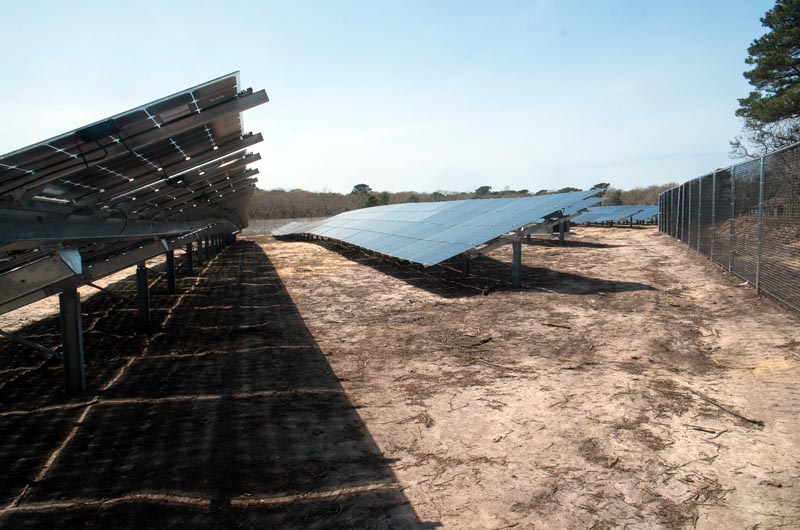More than three years after the town of Edgartown made a bet on green energy, the town's municipal solar sites are now feeding power back into the grid. But getting to this point has been anything but easy.
This is the largest operational municipal solar project on the Island, with two sites on town land, which together total 10.6 acres. Tisbury’s project at a capped landfill became operational last week.
The projects are managed by the Cape and Vineyard Electrical Cooperative, a group founded in 2007 to oversee renewable energy initiatives.
The largest of the two Edgartown projects is off Edgartown-Vineyard Haven Road in an area called Nunnepog, a Wampanoag name for Edgartown. That array, which occupies 5.8 acres and required the removal of trees and other vegetation, has been a source of concern for abutters. A fence was erected around the site, and trees were planted to obscure the panels, but neighbors have petitioned for taller trees and a darker-colored fence to block their view of the panels. The town has agreed to comply with the requests.

Out in Katama, the FARM Institute, a nonprofit teaching farm that leases the land from the town, lost six acres of grazing area to the solar arrays. In return, the town has designated an additional 14 acres for grazing purposes, which were originally going to be restricted to town use.
The town and CVEC have worked with neighbors to mitigate the impact of the projects, said Edgartown Board of Selectmen chairman Art Smadbeck.
“We try and do the best we can to fix it,” he said.
The seeds of the town’s solar efforts were planted in December 2010 when Edgartown residents voted unanimously at a special town meeting in favor of leasing land for renewable energy projects.
From the beginning, Mr. Smadbeck said he and his colleagues had an interest in generating green energy.
“We were very excited because what we were going to gain from it was not just participation in environmentally sound energy production but also more important, it was going to save money on the town’s electric bill,” he said.
But following the vote, the process of bringing the projects to fruition was fraught with obstacles.
“It was not a smooth road,” Mr. Smadbeck said. “It’s all new technology and there were a lot of players.”
When first exploring alternative energy options, the town considered solar and wind power options, but agreed that solar would be a more practical option.
“Wind is a great source around here,” said energy committee chairman Paul Pimentel. “The trouble is you have to get it up very high, away from the trees, and very big doesn’t go too well with people.”
In a study of possible locations for the solar arrays, 20 sites across town were considered, including the retired landfill on Meshacket Road. That site, though large enough, was not flat enough to support an extensive array.

The utility company NStar caused the worst of the delays, said Liz Argo, special projects coordinator at the Cape and Vineyard Electric Cooperative, in a telephone conversation this week.
“The biggest stumbling block has been the utility, and getting NStar to approve studies and plans and let these projects go to the second level,” she said.
In addition, she said all of the photovoltaic projects in the state have had to adapt to ongoing changes to the state incentive programs.
The contract with CVEC is for 20 years, but solar panels can last much longer, Ms. Argo said. In fact, panels installed at the Beverly High School in Beverly Massachusetts in the 1960s are still operational.
The power the panels produce is fed into the grid, offsetting the cost of the town’s electricity use. The panels will cover the town’s municipal load, with some energy left over to sell to other Cape and Vineyard Electric Cooperative members, like the County of Dukes County.
If all goes according to plan, in the first year the projects will generate an estimated $181,800 in earnings against the town’s electric bill.

Mr. Pimentel has committed to evaluating the performance of the panels on behalf of the town.
“I will review the town’s numbers and make sure we are getting what we are expecting to get,” he said.
The location of Edgartown’s solar facilities near residential neighborhoods has also worried some residents.
Katama homeowner Judy Valentine, for one, is concerned that her property has lost value since the municipal solar project went in nearby. She built her house in 1986.
“This was a beautiful, pristine property that wasn’t going to be touched,” she said this week at her home. “The panels are the ugliest thing I can imagine.”
Though she attended one meeting of the town regarding the project, the decision to build the solar array “already seemed etched in granite,” she said.
Mr. Smadbeck said the use of a new technology always involves some risk, but it’s a risk worth taking.
“If everybody just said, I will wait and see what the next guy does, then no one would do it,” he said. “I was very proud that the town voted to do this.”
In the meantime, Ms. Valentine says she hopes the energy cost savings are passed along to the taxpayer.
“I hope they are going to make a lot of money and lower our taxes,” she said.
An a previous version of this article incorrectly stated that Edgartown was the first town with an operational municipal solar project. In fact, Aquinnah went live with their solar array at the capped landfill in January 2013, through an agreement with Vineyard Power. We regret the error.







Comments (9)
Comments
Comment policy »